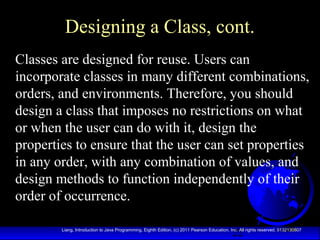Java™ (OOP) - Chapter 10: "Thinking in Objects"
- 1. 1Liang, Introduction to Java Programming, Eighth Edition, (c) 2011 Pearson Education, Inc. All rights reserved. 0132130807 Chapter 10 Thinking in Objects
- 2. 2Liang, Introduction to Java Programming, Eighth Edition, (c) 2011 Pearson Education, Inc. All rights reserved. 0132130807 Motivations You see the advantages of object-oriented programming from the preceding two chapters. This chapter will demonstrate how to solve problems using the object- oriented paradigm. Before studying these examples, we first introduce several language features for supporting these examples.
- 3. 3Liang, Introduction to Java Programming, Eighth Edition, (c) 2011 Pearson Education, Inc. All rights reserved. 0132130807 Objectives To create immutable objects from immutable classes to protect the contents of objects (§10.2). To determine the scope of variables in the context of a class (§10.3). To use the keyword this to refer to the calling object itself (§10.4). To apply class abstraction to develop software (§10.5). To explore the differences between the procedural paradigm and object-oriented paradigm (§10.6). To develop classes for modeling composition relationships (§10.7). To design programs using the object-oriented paradigm (§§10.8- 10.10). To design classes that follow the class-design guidelines (§10.11).
- 4. 4Liang, Introduction to Java Programming, Eighth Edition, (c) 2011 Pearson Education, Inc. All rights reserved. 0132130807 Immutable Objects and Classes If the contents of an object cannot be changed once the object is created, the object is called an immutable object and its class is called an immutable class. If you delete the set method in the Circle class in the preceding example, the class would be immutable because radius is private and cannot be changed without a set method. A class with all private data fields and without mutators is not necessarily immutable. For example, the following class Student has all private data fields and no mutators, but it is mutable.
- 5. 5Liang, Introduction to Java Programming, Eighth Edition, (c) 2011 Pearson Education, Inc. All rights reserved. 0132130807 Example public class Student { private int id; private BirthDate birthDate; public Student(int ssn, int year, int month, int day) { id = ssn; birthDate = new BirthDate(year, month, day); } public int getId() { return id; } public BirthDate getBirthDate() { return birthDate; } } public class BirthDate { private int year; private int month; private int day; public BirthDate(int newYear, int newMonth, int newDay) { year = newYear; month = newMonth; day = newDay; } public void setYear(int newYear) { year = newYear; } } public class Test { public static void main(String[] args) { Student student = new Student(111223333, 1970, 5, 3); BirthDate date = student.getBirthDate(); date.setYear(2010); // Now the student birth year is changed! } }
- 6. 6Liang, Introduction to Java Programming, Eighth Edition, (c) 2011 Pearson Education, Inc. All rights reserved. 0132130807 What Class is Immutable? For a class to be immutable, it must mark all data fields private and provide no mutator methods and no accessor methods that would return a reference to a mutable data field object.
- 7. 7Liang, Introduction to Java Programming, Eighth Edition, (c) 2011 Pearson Education, Inc. All rights reserved. 0132130807 Scope of Variables The scope of instance and static variables is the entire class. They can be declared anywhere inside a class. The scope of a local variable starts from its declaration and continues to the end of the block that contains the variable. A local variable must be initialized explicitly before it can be used.
- 8. 8Liang, Introduction to Java Programming, Eighth Edition, (c) 2011 Pearson Education, Inc. All rights reserved. 0132130807 The this Keyword The this keyword is the name of a reference that refers to an object itself. One common use of the this keyword is reference a class’s hidden data fields. Another common use of the this keyword to enable a constructor to invoke another constructor of the same class.
- 9. 9Liang, Introduction to Java Programming, Eighth Edition, (c) 2011 Pearson Education, Inc. All rights reserved. 0132130807 Reference the Hidden Data Fields public class Foo { private int i = 5; private static double k = 0; void setI(int i) { this.i = i; } static void setK(double k) { Foo.k = k; } } Suppose that f1 and f2 are two objects of Foo. Invoking f1.setI(10) is to execute this.i = 10, where this refers f1 Invoking f2.setI(45) is to execute this.i = 45, where this refers f2
- 10. 10Liang, Introduction to Java Programming, Eighth Edition, (c) 2011 Pearson Education, Inc. All rights reserved. 0132130807 Calling Overloaded Constructor public class Circle { private double radius; public Circle(double radius) { this.radius = radius; } public Circle() { this(1.0); } public double getArea() { return this.radius * this.radius * Math.PI; } } Every instance variable belongs to an instance represented by this, which is normally omitted this must be explicitly used to reference the data field radius of the object being constructed this is used to invoke another constructor
- 11. 11Liang, Introduction to Java Programming, Eighth Edition, (c) 2011 Pearson Education, Inc. All rights reserved. 0132130807 Class Abstraction and Encapsulation Class abstraction means to separate class implementation from the use of the class. The creator of the class provides a description of the class and let the user know how the class can be used. The user of the class does not need to know how the class is implemented. The detail of implementation is encapsulated and hidden from the user. Class Contract (Signatures of public methods and public constants) Class Class implementation is like a black box hidden from the clients Clients use the class through the contract of the class
- 12. 12Liang, Introduction to Java Programming, Eighth Edition, (c) 2011 Pearson Education, Inc. All rights reserved. 0132130807 Designing the Loan Class TestLoanClassTestLoanClass RunRunLoanLoan Loan -annualInterestRate: double -numberOfYears: int -loanAmount: double -loanDate: Date +Loan() +Loan(annualInterestRate: double, numberOfYears: int, loanAmount: double) +getAnnualInterestRate(): double +getNumberOfYears(): int +getLoanAmount(): double +getLoanDate(): Date +setAnnualInterestRate( annualInterestRate: double): void +setNumberOfYears( numberOfYears: int): void +setLoanAmount( loanAmount: double): void +getMonthlyPayment(): double +getTotalPayment(): double The annual interest rate of the loan (default: 2.5). The number of years for the loan (default: 1) The loan amount (default: 1000). The date this loan was created. Constructs a default Loan object. Constructs a loan with specified interest rate, years, and loan amount. Returns the annual interest rate of this loan. Returns the number of the years of this loan. Returns the amount of this loan. Returns the date of the creation of this loan. Sets a new annual interest rate to this loan. Sets a new number of years to this loan. Sets a new amount to this loan. Returns the monthly payment of this loan. Returns the total payment of this loan.
- 13. 13Liang, Introduction to Java Programming, Eighth Edition, (c) 2011 Pearson Education, Inc. All rights reserved. 0132130807 Object-Oriented Thinking Chapters 1-6 introduced fundamental programming techniques for problem solving using loops, methods, and arrays. The studies of these techniques lay a solid foundation for object-oriented programming. Classes provide more flexibility and modularity for building reusable software. This section improves the solution for a problem introduced in Chapter 3 using the object-oriented approach. From the improvements, you will gain the insight on the differences between the procedural programming and object-oriented programming and see the benefits of developing reusable code using objects and classes.
- 14. 14Liang, Introduction to Java Programming, Eighth Edition, (c) 2011 Pearson Education, Inc. All rights reserved. 0132130807 The BMI Class UseBMIClassUseBMIClass RunRunBMIBMI BMI -name: String -age: int -weight: double -height: double +BMI(name: String, age: int, weight: double, height: double) +BMI(name: String, weight: double, height: double) +getBMI(): double +getStatus(): String The name of the person. The age of the person. The weight of the person in pounds. The height of the person in inches. Creates a BMI object with the specified name, age, weight, and height. Creates a BMI object with the specified name, weight, height, and a default age 20. Returns the BMI Returns the BMI status (e.g., normal, overweight, etc.) The get methods for these data fields are provided in the class, but omitted in the UML diagram for brevity.
- 15. 15Liang, Introduction to Java Programming, Eighth Edition, (c) 2011 Pearson Education, Inc. All rights reserved. 0132130807 Example: The Course Class TestCourceTestCource RunRunCourseCourse Course -name: String -students: String[] -numberOfStudents: int +Course(name: String) +getName(): String +addStudent(student: String): void +getStudents(): String[] +getNumberOfStudents(): int The name of the course. The students who take the course. The number of students (default: 0). Creates a Course with the specified name. Returns the course name. Adds a new student to the course list. Returns the students for the course. Returns the number of students for the course.
- 16. 16Liang, Introduction to Java Programming, Eighth Edition, (c) 2011 Pearson Education, Inc. All rights reserved. 0132130807 Example: The StackOfIntegers Class RunRunTestStackOfIntegersTestStackOfIntegers StackOfIntegers -elements: int[] -size: int +StackOfIntegers() +StackOfIntegers(capacity: int) +empty(): boolean +peek(): int +push(value: int): int +pop(): int +getSize(): int An array to store integers in the stack. The number of integers in the stack. Constructs an empty stack with a default capacity of 16. Constructs an empty stack with a specified capacity. Returns true if the stack is empty. Returns the integer at the top of the stack without removing it from the stack. Stores an integer into the top of the stack. Removes the integer at the top of the stack and returns it. Returns the number of elements in the stack.
- 17. 17Liang, Introduction to Java Programming, Eighth Edition, (c) 2011 Pearson Education, Inc. All rights reserved. 0132130807 Designing the StackOfIntegers Class Data1 Data2 Data1 Data1 Data2 Data3 Data1 Data2 Data3 Data1 Data2 Data3 Data1 Data2 Data1
- 18. 18Liang, Introduction to Java Programming, Eighth Edition, (c) 2011 Pearson Education, Inc. All rights reserved. 0132130807 Implementing StackOfIntegers Class StackOfIntegersStackOfIntegers . . . . . . elements[0] elements[1] elements[size-1] capacity top bottom size elements[capacity – 1]
- 19. 19Liang, Introduction to Java Programming, Eighth Edition, (c) 2011 Pearson Education, Inc. All rights reserved. 0132130807 Designing the GuessDate Class UseGuessDateClassUseGuessDateClass RunRunGuessDateGuessDate GuessDate -dates: int[][][] +getValue(setNo: int, row: int, column: int): int The static array to hold dates. Returns a date at the specified row and column in a given set.
- 20. 20Liang, Introduction to Java Programming, Eighth Edition, (c) 2011 Pearson Education, Inc. All rights reserved. 0132130807 Designing a Class (Coherence) A class should describe a single entity, and all the class operations should logically fit together to support a coherent purpose. You can use a class for students, for example, but you should not combine students and staff in the same class, because students and staff have different entities.
- 21. 21Liang, Introduction to Java Programming, Eighth Edition, (c) 2011 Pearson Education, Inc. All rights reserved. 0132130807 Designing a Class, cont. (Separating responsibilities) A single entity with too many responsibilities can be broken into several classes to separate responsibilities. The classes String, StringBuilder, and StringBuffer all deal with strings, for example, but have different responsibilities. The String class deals with immutable strings, the StringBuilder class is for creating mutable strings, and the StringBuffer class is similar to StringBuilder except that StringBuffer contains synchronized methods for updating strings.
- 22. 22Liang, Introduction to Java Programming, Eighth Edition, (c) 2011 Pearson Education, Inc. All rights reserved. 0132130807 Designing a Class, cont. Classes are designed for reuse. Users can incorporate classes in many different combinations, orders, and environments. Therefore, you should design a class that imposes no restrictions on what or when the user can do with it, design the properties to ensure that the user can set properties in any order, with any combination of values, and design methods to function independently of their order of occurrence.
- 23. 23Liang, Introduction to Java Programming, Eighth Edition, (c) 2011 Pearson Education, Inc. All rights reserved. 0132130807 Designing a Class, cont. Provide a public no-arg constructor and override the equals method and the toString method defined in the Object class whenever possible.
- 24. 24Liang, Introduction to Java Programming, Eighth Edition, (c) 2011 Pearson Education, Inc. All rights reserved. 0132130807 Designing a Class, cont. Follow standard Java programming style and naming conventions. Choose informative names for classes, data fields, and methods. Always place the data declaration before the constructor, and place constructors before methods. Always provide a constructor and initialize variables to avoid programming errors.
- 25. 25Liang, Introduction to Java Programming, Eighth Edition, (c) 2011 Pearson Education, Inc. All rights reserved. 0132130807 Using Visibility Modifiers Each class can present two contracts – one for the users of the class and one for the extenders of the class. Make the fields private and accessor methods public if they are intended for the users of the class. Make the fields or method protected if they are intended for extenders of the class. The contract for the extenders encompasses the contract for the users. The extended class may increase the visibility of an instance method from protected to public, or change its implementation, but you should never change the implementation in a way that violates that contract.
- 26. 26Liang, Introduction to Java Programming, Eighth Edition, (c) 2011 Pearson Education, Inc. All rights reserved. 0132130807 Using Visibility Modifiers, cont. A class should use the private modifier to hide its data from direct access by clients. You can use get methods and set methods to provide users with access to the private data, but only to private data you want the user to see or to modify. A class should also hide methods not intended for client use. The gcd method in the Rational class in Example 11.2, “The Rational Class,” is private, for example, because it is only for internal use within the class.
- 27. 27Liang, Introduction to Java Programming, Eighth Edition, (c) 2011 Pearson Education, Inc. All rights reserved. 0132130807 Using the static Modifier A property that is shared by all the instances of the class should be declared as a static property.


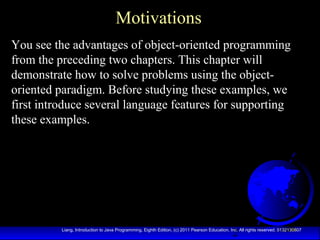

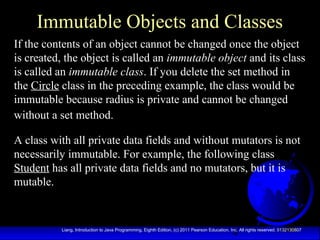
![5Liang, Introduction to Java Programming, Eighth Edition, (c) 2011 Pearson Education, Inc. All rights reserved. 0132130807
Example
public class Student {
private int id;
private BirthDate birthDate;
public Student(int ssn,
int year, int month, int day) {
id = ssn;
birthDate = new BirthDate(year, month, day);
}
public int getId() {
return id;
}
public BirthDate getBirthDate() {
return birthDate;
}
}
public class BirthDate {
private int year;
private int month;
private int day;
public BirthDate(int newYear,
int newMonth, int newDay) {
year = newYear;
month = newMonth;
day = newDay;
}
public void setYear(int newYear) {
year = newYear;
}
}
public class Test {
public static void main(String[] args) {
Student student = new Student(111223333, 1970, 5, 3);
BirthDate date = student.getBirthDate();
date.setYear(2010); // Now the student birth year is changed!
}
}](https://image.slidesharecdn.com/10slide-140507081146-phpapp01/85/Java-OOP-Chapter-10-Thinking-in-Objects-5-320.jpg)
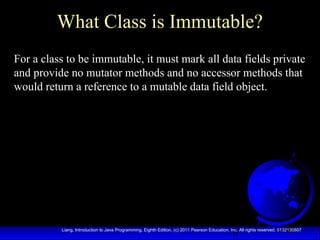




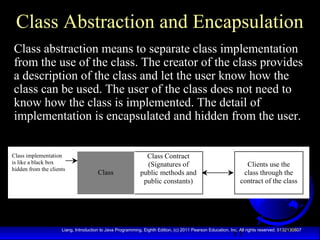

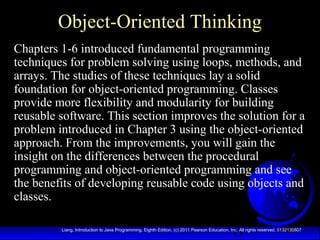

![15Liang, Introduction to Java Programming, Eighth Edition, (c) 2011 Pearson Education, Inc. All rights reserved. 0132130807
Example: The Course Class
TestCourceTestCource RunRunCourseCourse
Course
-name: String
-students: String[]
-numberOfStudents: int
+Course(name: String)
+getName(): String
+addStudent(student: String): void
+getStudents(): String[]
+getNumberOfStudents(): int
The name of the course.
The students who take the course.
The number of students (default: 0).
Creates a Course with the specified name.
Returns the course name.
Adds a new student to the course list.
Returns the students for the course.
Returns the number of students for the course.](https://image.slidesharecdn.com/10slide-140507081146-phpapp01/85/Java-OOP-Chapter-10-Thinking-in-Objects-15-320.jpg)
![16Liang, Introduction to Java Programming, Eighth Edition, (c) 2011 Pearson Education, Inc. All rights reserved. 0132130807
Example: The
StackOfIntegers Class
RunRunTestStackOfIntegersTestStackOfIntegers
StackOfIntegers
-elements: int[]
-size: int
+StackOfIntegers()
+StackOfIntegers(capacity: int)
+empty(): boolean
+peek(): int
+push(value: int): int
+pop(): int
+getSize(): int
An array to store integers in the stack.
The number of integers in the stack.
Constructs an empty stack with a default capacity of 16.
Constructs an empty stack with a specified capacity.
Returns true if the stack is empty.
Returns the integer at the top of the stack without
removing it from the stack.
Stores an integer into the top of the stack.
Removes the integer at the top of the stack and returns it.
Returns the number of elements in the stack.](https://image.slidesharecdn.com/10slide-140507081146-phpapp01/85/Java-OOP-Chapter-10-Thinking-in-Objects-16-320.jpg)

![18Liang, Introduction to Java Programming, Eighth Edition, (c) 2011 Pearson Education, Inc. All rights reserved. 0132130807
Implementing
StackOfIntegers Class
StackOfIntegersStackOfIntegers
.
.
.
.
.
.
elements[0]
elements[1]
elements[size-1]
capacity
top
bottom
size
elements[capacity – 1]](https://image.slidesharecdn.com/10slide-140507081146-phpapp01/85/Java-OOP-Chapter-10-Thinking-in-Objects-18-320.jpg)
![19Liang, Introduction to Java Programming, Eighth Edition, (c) 2011 Pearson Education, Inc. All rights reserved. 0132130807
Designing the GuessDate Class
UseGuessDateClassUseGuessDateClass RunRunGuessDateGuessDate
GuessDate
-dates: int[][][]
+getValue(setNo: int, row: int,
column: int): int
The static array to hold dates.
Returns a date at the specified row and column in a given set.](https://image.slidesharecdn.com/10slide-140507081146-phpapp01/85/Java-OOP-Chapter-10-Thinking-in-Objects-19-320.jpg)


